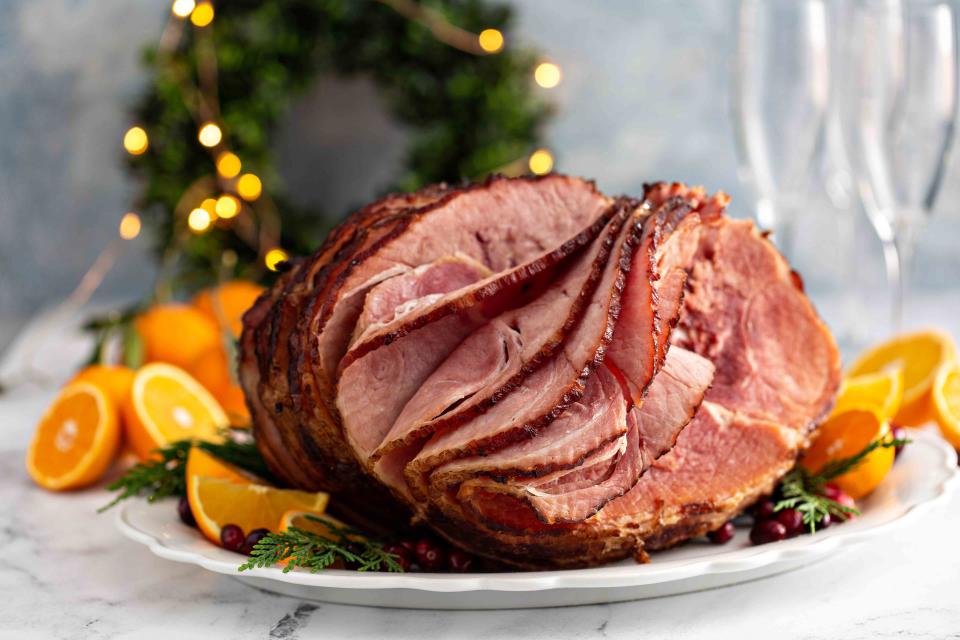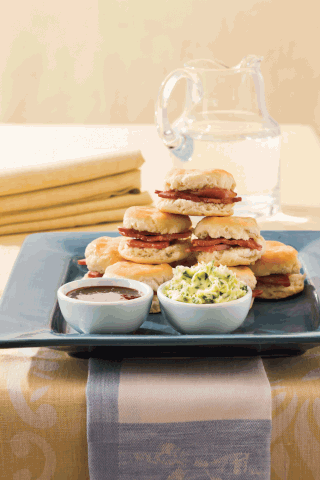A Genuine Smithfield Ham Can Only Hail From Smithfield, VA
Bless my mama and all those who are cooking one this Christmas

Getty
A true Virginian knows there is nothing better than a Genuine Smithfield ham. It’s the star of every holiday meal, whether it’s stuffed into a biscuit, served in thin slices on a platter, or accompanying jumbo-lump crab meat, nothing, not even the Thanksgiving turkey takes precedence, at least in my very biased, Virginia-raised opinion.
What Is Smithfield Ham?
If you aren’t familiar with Smithfield ham, you should be. It’s a type of country ham that by law can only come from one place on earth: Smithfield, Virginia. It’s the perfect salty bite with just the right amount of fat that almost melts on your tongue. As my mother says, “there’s nothing quite like it.”
Smithfield is a little town in the heart of Isle of Wight county. The town mainly consists of one main street where ham biscuits, peanuts and antiques are plentiful: a true Virginian’s dream. It also happens to be the location of Smithfield Foods, which was started by the Luter family in the 1930s and has grown into one of the biggest food manufacturers in the industry. Smithfield Foods isn’t the only company you can get a Genuine Smithfield Ham from, however. As long as that ham is made in the town of Smithfield, it’s a Genuine Smithfield ham, according to the Code of Virginia which is where all general and permanent laws in Virginia are documented. The Code of Virginia has an entire section on Smithfield Ham, which most Virginia residents know by heart, or at least, that seems to be the case when I talk to my father and his friends about this special ham.
Why My Family Goes "Hog Wild" On Ham
When I decided to write about my favorite salty treat, the first thing I knew I needed to do was talk to my dad. If you haven’t had the pleasure of meeting Mr. Russell, he’s the quintessential Virginia gentleman. He grew up in what he described to me once as hog country just a few miles away from Smithfield itself. One of his favorite childhood memories is when he would visit his Uncle Stanley’s farm with his mother to pick up hams for Christmas. Uncle Stanley once raised hogs, but he couldn’t keep up with regulations as the years passed on. Dad also loves hunting, reading Robert Ruark and wearing his coat and tie. If that does not sound like a true Virginia gentleman to you, I simply don’t believe that you’ve ever visited our fine state. The thing in life that defines my father the most as a Virginia gentleman, however, is his love of food.
Mr. Russell is a small man, but he eats more than anyone else I’ve ever known. Of course, his favorite thing to eat is Smithfield ham. Yes, he loves peanuts, fried chicken and caramel cake, but there is nothing that he loves more than a Genuine Smithfield ham.
"There's Nothing Quite Like It"
Ham is a year-round topic of conversation in the Russell house. The search for the perfect Christmas ham seems to start in September and almost every year my dad tries to convince my mom to bake two hams over the holidays: one for Christmas and one for Thanksgiving. So far, he hasn’t won, although my mom has bought more than one ham because she was worried that the first ham would not fit my father’s high standards. If you haven’t caught on yet, ham is a big deal, especially where my father is concerned.

How To Ham The Russell Way
There are certain ways of doing things when it comes to ham. For instance, my father believes salty, country hams are made for eating during the holiday season in particular. For Thanksgiving, we usually just pick up an Edwards Petit Country Ham or ask for a pound of Smithfield ham to be thinly sliced from the grocery store deli. In some parts of the world, it’s easier to just say “salty ham” than Smithfield so people know what you’re talking about. My father eats this ham, but let’s just say, he knows better ham awaits him in the weeks ahead.
When it comes to the actual Smithfield ham that we cook for Christmas, it’s a big to-do. First, there is the matter of scraping off the mold. I asked my mom about this and she explained to me that it’s no big deal. Although, for someone who didn’t fully process this detail until a few years ago, it feels like one. Since Smithfield hams have to be cured for a certain amount of time and then stored, mold is inevitable. After the mold has been scraped, your Smithfield ham is ready for soaking. My mother soaks our hams in the laundry room sink for about 32 hours, depending on what the directions say on the muslin bag (the one all great country hams come in).
After soaking the ham, my mother makes the journey from our laundry room sink to our oven with our prized pig. Before the ham makes it into the oven, my mother creates an elaborate little tin-foil outfit for the ham to wear so it cooks as evenly as possible. After getting dressed, the ham is ready to be baked for several hours, and then comes the fun part.
The 15-pound ham is pulled from the oven and the moment my father is barely able to touch it, he gets to work. He grabs his trusty bread knife and goes to work slicing off the hefty layer of fat on the ham. He tries to cut the fat as close to the meat as possible without actually cutting any meat. It’s like watching an experienced artisan performing a craft. His hands glisten with all of the fat from the ham and the rest of us, dogs included, crowd around waiting for him to offer us a piece of warm meat. He thoughtfully chooses pieces that he thinks each of us will enjoy, while making sure the best stays intact for company.
That layer of fat he cut off plays a crucial role in the rest of the ham’s life. The fat layer is put back on the ham after every slicing process to ensure that the meat does not dry out. We also add a layer of cling wrap AND tin foil before it’s stored in the fridge, if you’re so curious.
Once the ham cools, it’s time to dig in for real. Slicing the ham is the part of the ham process when my dad is not just particular, he’s territorial. Sometimes my mom is allowed to slice the ham, but if Dad’s around, he’s doing it. “Good Smithfield ham slices should be as thin as possible,” my dad shares. He continues: “My mother used to say you should be able to see through a ham slice,” and since that’s what his mama did, we try our darndest to do it, too. The oh-so-carefully cut slices are then spread out on a platter and ready to be served.
* Please Note: This is an idealized scenario. Most of the time, there’s trouble in this ham paradise. My parents recalled their two favorite ham-tastrophies separately. My father recalls one time when my parents boiled a ham and it boiled over onto the stove top. He says, “That wasn’t the ham’s fault.” My mother remembers when a ham decided to jump from the oven onto the floor. The ham was so hot my parents couldn’t pick it up. She can still picture my dad slipping in the ham grease, attempting to rescue his prized-porker.
How To Eat Smithfield Ham
In Virginia, ham is good on everything. We put it in our Brunswick stew, our black-eyed peas and sometimes, we even add a slice to a piece of cake. Yet, my purist father believes ham is best served in a sandwich with two pieces of white bread and a healthy layer of mayonnaise. He also loves ham in rolls or biscuits. He even loves ham on its own. He does have some favorite Southern dishes that he loves to eat with ham specifically: “collard greens with watermelon rind pickle, mashed potatoes, green beans cooked with ham hock, fried chicken and hot rolls from the stump up,” which is his special way of saying from scratch. He also notes that on Christmas and Thanksgiving day, the fried chicken can be replaced with turkey, if you feel so inclined.
So friends, if you are planning your Christmas menus and looking for the one thing that will set it over the top, this is it. A Genuine Smithfield ham will never treat your taste buds wrong, especially if you prefer the finer things in life. In Virginia, we know how to do the holidays right, so just trust us on this one and pick up a few slices or a whole ham for yourself.
For more Southern Living news, make sure to sign up for our newsletter!
Read the original article on Southern Living.

